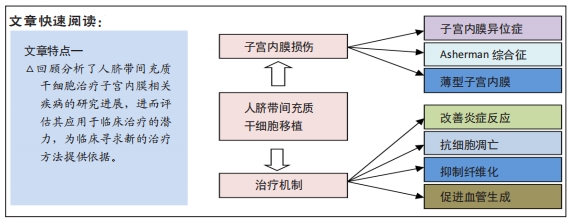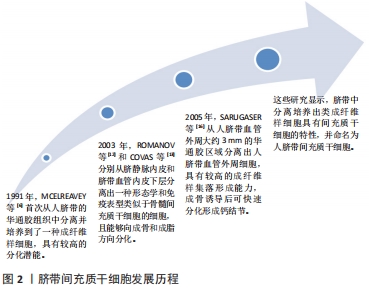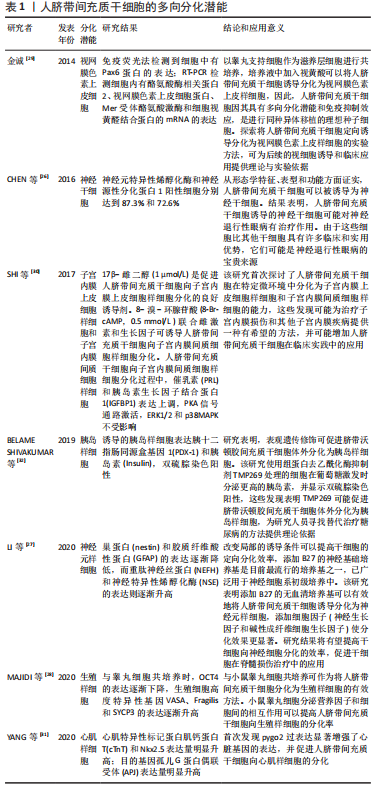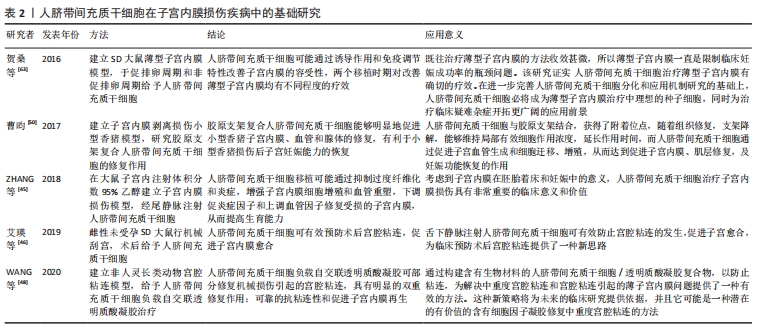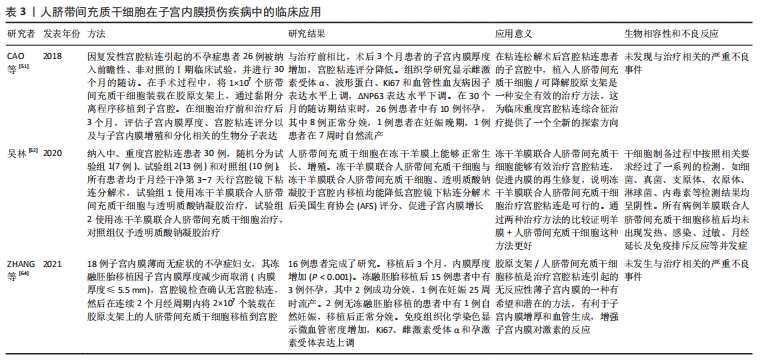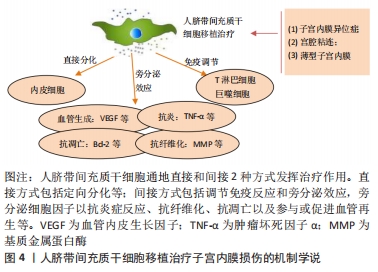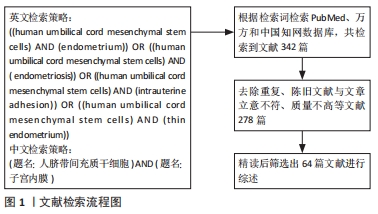[1] 勾亚婷,张文文,李长江,等.NF-κB信号通路在人羊膜间充质干细胞治疗宫腔粘连中的作用[J].第三军医大学学报,2020,42(11):1101-1108.
[2] SONG A, WANG J, TONG Y, et al. BKCa channels regulate the immunomodulatory properties of WJ-MSCs by affecting the exosome protein profiles during the inflammatory response. Stem Cell Res Ther. 2020;11(1):440.
[3] 汪子涵,刘义,鞠明艳,等.间充质干细胞治疗成骨不全:是直接分化为功能细胞还是旁分泌作用[J].中国组织工程研究,2018,22(33):5373-5378.
[4] BABENKO VA, SILACHEV DN, DANILINA TI, et al. Age-Related Changes in Bone-Marrow Mesenchymal Stem Cells. Cells. 2021;10(6):1273.
[5] ZHAN XS, EL-ASHRAM S, LUO DZ, et al. A comparative study of biological characteristics and transcriptome profiles of mesenchymal stem cells from different canine tissues. Int J Mol Sci. 2019;20(6):1485.
[6] MCELREAVEY KD, IRVINE AI, ENNIS KT, et al. Isolation, culture and characterisation of fibroblast-like cells derived from the Wharton’s jelly portion of human umbilical cord. Biochem Soc Trans. 1991;19(1):29S.
[7] BAI X, LIU J, CAO S, et al. Mechanisms of endometrial fibrosis and the potential application of stem cell therapy. Discov Med. 2019;27(150):267-279.
[8] FAN D, WU S, YE S, et al. Umbilical cord mesenchyme stem cell local intramuscular injection for treatment of uterine niche: protocol for a prospective, randomized, double-blinded, placebo-controlled clinical trial. Medicine (Baltimore). 2017;96(44):e8480.
[9] XIA L, MENG Q, XI J, et al. The synergistic effect of electroacupuncture and bone mesenchymal stem cell transplantation on repairing thin endometrial injury in rats. Stem Cell Res Ther. 2019;10(1):244.
[10] SHAO X, AI G, WANG L, et al. Adipose-derived stem cells transplantation improves endometrial injury repair. Zygote. 2019;27(6):367-374.
[11] SINGH N, SHEKHAR B, MOHANTY S, et al. Autologous bone marrow-derived stem cell therapy for asherman’s syndrome and endometrial atrophy: a 5-year follow-up study. J Hum Reprod Sci. 2020;13(1):31-37.
[12] ROMANOV YA, SVINTSITSKAYA VA, SMIRNOV VN. Searching for alternative sources of postnatal human mesenchymal stem cells: candidate MSC-like cells from umbilical cord. Stem Cells. 2003;21(1):105-110.
[13] COVAS DT, SIUFI JL, SILVA AR, et al. Isolation and culture of umbilical vein mesenchymal stem cells. Braz J Med Biol Res. 2003;36(9):1179-1183.
[14] MITCHELL KE, WEISS ML, MITCHELL BM, et al. Matrix cells from Wharton’s jelly form neurons and glia. Stem Cells. 2003;21(1):50-60.
[15] MA L, FENG XY, CUI BL, et al. Human umbilical cord Wharton’s Jelly-derived mesenchymal stem cells differentiation into nerve-like cells. Chin Med J (Engl). 2005;118(23):1987-1993.
[16] SARUGASER R, LICKORISH D, BAKSH D, et al. Human umbilical cord perivascular (HUCPV) cells: a source of mesenchymal progenitors. Stem Cells. 2005;23(2):220-229.
[17] BEERAVOLU N, MCKEE C, ALAMRI A, et al. Isolation and characterization of mesenchymal stromal cells from human umbilical cord and fetal placenta. J Vis Exp. 2017;(122):55224.
[18] HU Y, ZHANG Y, NI CY, et al. Human umbilical cord mesenchymal stromal cells-derived extracellular vesicles exert potent bone protective effects by CLEC11A-mediated regulation of bone metabolism. Theranostics. 2020; 10(5):2293-2308.
[19] IWATANI S, YOSHIDA M, YAMANA K, et al. Isolation and characterization of human umbilical cord-derived mesenchymal stem cells from preterm and term infants. J Vis Exp. 2019;(143):58806.
[20] SHI Y, NAN C, YAN Z, et al. Synaptic plasticity of human umbilical cord mesenchymal stem cell differentiating into neuron-like cells in vitro induced by edaravone. Stem Cells Int. 2018;2018:5304279.
[21] ABOU-ELNAGA A, EL-CHENNAWI F, IBRAHIM KAMEL S, et al. The potentiality of human umbilical cord isolated mesenchymal stem/stromal cells for cardiomyocyte generation. Stem Cells Cloning. 2020;13:91-101.
[22] GUAN YT, XIE Y, LI DS, et al. Comparison of biological characteristics of mesenchymal stem cells derived from the human umbilical cord and decidua parietalis. Mol Med Rep. 2019;20(1):633-639.
[23] PAN XH, HUANG X, RUAN GP, et al. Umbilical cord mesenchymal stem cells are able to undergo differentiation into functional islet-like cells in type 2 diabetic tree shrews. Mol Cell Probes. 2017;34:1-12.
[24] SHI Q, GAO J, JIANG Y, et al. Differentiation of human umbilical cord Wharton’s jelly-derived mesenchymal stem cells into endometrial cells. Stem Cell Res Ther. 2017;8(1):246.
[25] ZHANG S, ZHANG W, LI Y, et al. Human umbilical cord mesenchymal stem cell differentiation into odontoblast-like cells and endothelial cells: a potential cell source for dental pulp tissue engineering. Front Physiol. 2020;11:593.
[26] CHEN S, ZHANG W, WANG JM, et al. Differentiation of isolated human umbilical cord mesenchymal stem cells into neural stem cells. Int J Ophthalmol. 2016;9(1):41-47.
[27] LI Y, YANG J, FU G, et al. Human umbilical cord mesenchymal stem cells differentiate into neuron-like cells after induction with B27-supplemented serum-free medium. Nan Fang Yi Ke Da Xue Xue Bao. 2020;40(9):1340-1345.
[28] MAJIDI F, BAMEHR H, SHALCHIAN Z, et al. Differentiation of human umbilical cord mesenchymal stem cell into germ-like cell under effect of co-culture with testicular cell tissue. Anat Histol Embryol. 2020;49(3):359-364.
[29] 金诚.人脐带间充质干细胞向视网膜色素上皮细胞分化的研究[J].石家庄:河北医科大学,2014.
[30] SHI Q, GAO J, JIANG Y, et al. Differentiation of human umbilical cord Wharton’s jelly-derived mesenchymal stem cells into endometrial cells. Stem Cell Res Ther. 2017;8(1):246.
[31] YANG L, ZHU S, LI Y, et al. Overexpression of Pygo2 increases differentiation of human umbilical cord mesenchymal stem cells into cardiomyocyte-like cells. Curr Mol Med. 2020;20(4):318-324.
[32] BELAME SHIVAKUMAR S, BHARTI D, BAREGUNDI SUBBARAO R, et al. Pancreatic endocrine-like cells differentiated from human umbilical cords Wharton’s jelly mesenchymal stem cells using small molecules. J Cell Physiol. 2019;234(4):3933-3947.
[33] VILLEDA SA, PLAMBECK KE, MIDDELDORP J, et al. Young blood reverses age-related impairments in cognitive function and synaptic plasticity in mice. Nat Med. 2014;20(6):659-663.
[34] MILLÁN-RIVERO JE, NADAL-NICOLÁS FM, GARCÍA-BERNAL D, et al. Human Wharton’s jelly mesenchymal stem cells protect axotomized rat retinal ganglion cells via secretion of anti-inflammatory and neurotrophic factors. Sci Rep. 2018;8(1):16299.
[35] THAWEESAPPHITHAK S, TANTRAWATPAN C, KHEOLAMAI P, et al. Human serum enhances the proliferative capacity and immunomodulatory property of MSCs derived from human placenta and umbilical cord. Stem Cell Res Ther. 2019;10(1):79.
[36] YAGHOUBI Y, MOVASSAGHPOUR A, ZAMANI M, et al. Human umbilical cord mesenchymal stem cells derived-exosomes in diseases treatment. Life Sci. 2019;233:116733.
[37] YIN S, JI C, WU P, et al. Human umbilical cord mesenchymal stem cells and exosomes: bioactive ways of tissue injury repair. Am J Transl Res. 2019;11(3): 1230-1240.
[38] MAO F, WU Y, TANG X, et al. Exosomes derived from human umbilical cord mesenchymal stem cells relieve inflammatory bowel disease in mice. Biomed Res Int. 2017;2017:5356760.
[39] 梁亚会,张青宜,郭子宽,等.人脐带间充质干细胞来源的外泌体免疫调节功能异质性研究[J].军事医学,2017,41(6):434-439.
[40] 郭礼妍,赖沛龙,耿素霞.等.人脐带间充质干细胞来源外泌体对Treg和TH17细胞的调节作用[J].中国实验血液学杂志,2019,27(1):221-226.
[41] SASSON IE, TAYLOR HS. Stem cells and the pathogenesis of endometriosis. Ann N Y Acad Sci. 2008;1127:106-115.
[42] CECCARONI M, ROVIGLIONE G, ROSENBERG P, et al. Pericardial, pleural and diaphragmatic endometriosis in association with pelvic peritoneal and bowel endometriosis: a case report and review of the literature. Wideochir Inne Tech Maloinwazyjne. 2012;7(2):122-131.
[43] 李清雪,陈景伟,杨剑.OTUD7B对子宫内膜异位症患者子宫内膜基质细胞增殖、侵袭与凋亡的影响[J].中国临床药理学杂志,2021,37(8): 1004-1007.
[44] 王春梅,李洁,孙文萍,等.人脐带间充质干细胞对异位子宫内膜细胞增殖及凋亡的影响[J].中国组织工程研究,2015,19(41):6628-6632.
[45] ZHANG L, LI Y, GUAN CY, et al. Therapeutic effect of human umbilical cord-derived mesenchymal stem cells on injured rat endometrium during its chronic phase. Stem Cell Res Ther. 2018;9(1):36.
[46] 艾瑛,廖诗平,王玉芳,等.脐带间充质干细胞移植预防宫腔粘连的研究[J].现代妇产科进展,2019,28(5):342-345.
[47] 江春燕.左归丸联合脐带间充质干细胞修复受损子宫内膜的研究[D].武汉:湖北中医药大学,2017.
[48] WANG L, YU C, CHANG T, et al. In situ repair abilities of human umbilical cord-derived mesenchymal stem cells and autocrosslinked hyaluronic acid gel complex in rhesus monkeys with intrauterine adhesion. Sci Adv. 2020;6(21):eaba6357.
[49] LIU Y, CAI J, LUO X, et al. Collagen scaffold with human umbilical cord mesenchymal stem cells remarkably improves intrauterine adhesions in a rat model. Gynecol Obstet Invest. 2020;85(3):267-276.
[50] 曹昀.干细胞治疗宫腔粘连综合征的机制研究和临床转化[D].南京:南京大学,2017.
[51] CAO Y, SUN H, ZHU H, et al. Allogeneic cell therapy using umbilical cord MSCs on collagen scaffolds for patients with recurrent uterine adhesion: a phase I clinical trial. Stem Cell Res Ther. 2018;9(1):192.
[52] 吴林.冻干羊膜联合人脐带间充质干细胞治疗中重度宫腔粘连的研究[D].衡阳:南华大学,2020.
[53] HEGER A, SATOR M, PIETROWSKI D. Endometrial receptivity and its predictive value for IVF/ICSI-outcome. Geburtshilfe Frauenheilkd. 2012; 72(8):710-715.
[54] MAHAJAN N, SHARMA S. The endometrium in assisted reproductive technology: how thin is thin? J Hum Reprod Sci. 2016;9(1):3-8.
[55] BAKOS O, LUNDKVIST O, BERGH T. Transvaginal sonographic evaluation of endometrial growth and texture in spontaneous ovulatory cycles-a descriptive study. Hum Reprod. 1993;8(6):799-806.
[56] GROW DR, IROMLOO K. Oral contraceptives maintain a very thin endometrium before operative hysteroscopy. Fertil Steril. 2006;85(1):204-207.
[57] LIU KE, HARTMAN M, HARTMAN A. Management of thin endometrium in assisted reproduction: a clinical practice guideline from the Canadian Fertility and Andrology Society. Reprod Biomed Online. 2019;39(1):49-62.
[58] MIWA I, TAMURA H, TAKASAKI A, et al. Pathophysiologic features of ‘thin’ endometrium. Fertil Steril. 2009;91:998-1004.
[59] AL-GHAMDI A, COSKUN S, AL-HASSAN S, et al. The correlation between endometrial thickness and outcome of in vitro fertilization and embryo transfer (IVF-ET) outcome. Reprod Biol Endocrinol. 2008;6:37.
[60] AZIZI R, AGHEBATI-MALEKI L, NOURI M, et al. Stem cell therapy in Asherman syndrome and thin endometrium: stem cell-based therapy. Biomed Pharmacother. 2018;102:333-343.
[61] YE MX, YU L, WANG SF, et al. Efficacy of gamma-irradiated adipose-derived stem cells for treatment of thin endometrium in rats. Nan Fang Yi Ke Da Xue Xue Bao. 2017;37(5):575-580.
[62] MENG QY, XI J, XIA LJ, et al. Effect of combined administration of electroacupuncture and mesenchymal stem cells on expression of endometrium estrogen receptor and progesterone receptor in thin endometrium rats. Zhen Ci Yan Jiu. 2021;46(5):385-390.
[63] 贺桑,卢永娟,黄向红,等.人脐带间充质干细胞移植对大鼠薄型子宫内膜的治疗作用[J].中国医学前沿杂志(电子版),2016,8(9):67-72.
[64] ZHANG Y, SHI L, LIN X, et al. Unresponsive thin endometrium caused by Asherman syndrome treated with umbilical cord mesenchymal stem cells on collagen scaffolds: a pilot study. Stem Cell Res Ther. 2021;12(1):420.
|
